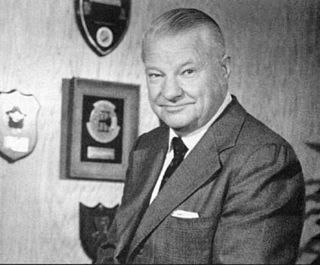Related Research Articles

A flight simulator is a device that artificially re-creates aircraft flight and the environment in which it flies, for pilot training, design, or other purposes. It includes replicating the equations that govern how aircraft fly, how they react to applications of flight controls, the effects of other aircraft systems, and how the aircraft reacts to external factors such as air density, turbulence, wind shear, cloud, precipitation, etc. Flight simulation is used for a variety of reasons, including flight training, the design and development of the aircraft itself, and research into aircraft characteristics and control handling qualities.

Dassault Aviation SA is an international French aircraft manufacturer of military and business jets, and is a subsidiary of Dassault Group.

Juan Terry Trippe was an American commercial aviation pioneer, entrepreneur and the founder of Pan American World Airways, one of the iconic airlines of the 20th century. He was instrumental in numerous revolutionary advances in airline history, including the development and production of the Boeing 314 Clipper, which opened trans-Pacific airline travel, the Boeing Stratoliner which helped to pioneer cabin pressurization, the Boeing 707 and the Boeing 747 which introduced the era of jumbo jets. Trippe's signing of the 747 contract coincided with the 50th anniversary of Boeing, and he gave a speech where he explained his belief that these jets would be a force that would help bring about world peace.

L3 Technologies, formerly L-3 Communications Holdings, was an American company that supplied command and control, communications, intelligence, surveillance and reconnaissance (C3ISR) systems and products, avionics, ocean products, training devices and services, instrumentation, aerospace, and navigation products. Its customers included the Department of Defense, Department of Homeland Security, United States Intelligence Community, NASA, aerospace contractors, and commercial telecommunications and wireless customers. In 2019, it merged with Harris Corporation and was renamed to L3Harris Technologies.

CAE Inc. is a Canadian manufacturer of simulation technologies, modelling technologies and training services to airlines, aircraft manufacturers, healthcare specialists, and defence customers. CAE was founded in 1947, and has manufacturing operations and training facilities in 35 countries. In 2017, the company's annual revenue was CAD $2.705 billion.

William John "Jack" Frye was an aviation pioneer in the airline industry. Frye founded Standard Air Lines which eventually took him into a merger with Trans World Airlines (TWA) where he became president. Frye is credited for turning TWA into a world-class airline during his tenure as president from 1934 to 1947.

James Charles Floyd is a Canadian aerospace engineer. He was the Avro Aircraft Ltd. (Canada) chief design engineer. His ensuing involvement, ultimately as vice-president (engineering), in the design and development of the Avro Jetliner, CF-100 and CF-105 Arrow aircraft designs, over a period which is viewed by many as the "Golden Age" of the Canadian aviation industry.
SPAR Aerospace was a Canadian aerospace company. It produced equipment for the Canadian Space Agency to be used in cooperation with NASA's Space Shuttle program, most notably the Canadarm, a remote manipulator system.

The Aviation Centre of Excellence, or ACE, is the aviation department facility for Confederation College. The 59,000-square-foot (5,500 m2) state-of-the-art building comprises two large hangars, classrooms, shops, labs, and offices for the three aviation programs at the School of Aviation.
CAE Oxford, part of CAE Inc., is an ab initio flight training network. It provides integrated aviation training and resourcing services. Professional airline pilots have been trained at Oxford Aviation Academy flight school since 1961.
Korea Aerospace University is a private university in Goyang, Gyeonggi, South Korea.
William Brenton Boggs IV, was a pioneering Canadian leader in military and commercial aviation.
CAT is an international simulation and training publication produced bi-monthly in the UK by Halldale Media. CAT was first published in 1990, and has provided continuous, international coverage ever since with its worldwide team of journalists.

Clarence Leonard "Kelly" Johnson was an American aeronautical and systems engineer. He is recognized for his contributions to a series of important aircraft designs, most notably the Lockheed U-2 and SR-71 Blackbird. Besides the first production aircraft to exceed Mach 3, he also produced the first fighter capable of Mach 2, the United States' first operational jet fighter, as well as the first fighter to exceed 400 mph, and many other contributions to various aircraft. As a member and first team leader of the Lockheed Skunk Works, Johnson worked for more than four decades and is said to have been an "organizing genius". He played a leading role in the design of over forty aircraft, including several honored with the prestigious Collier Trophy, acquiring a reputation as one of the most talented and prolific aircraft design engineers in the history of aviation. In 2003, as part of its commemoration of the 100th anniversary of the Wright Brothers' flight, Aviation Week & Space Technology ranked Johnson eighth on its list of the top 100 "most important, most interesting, and most influential people" in the first century of aerospace. Hall Hibbard, Johnson's Lockheed boss, referring to Johnson's Swedish ancestry, once remarked to Ben Rich: "That damned Swede can actually see air."

GSE Systems, Inc. develops and markets software-based simulation and training products to nuclear, oil, and gas electricity generators, and the chemical process industries. It also sells software for monitoring and optimizing plant and signal analysis to the power industry.
Mechtronix Inc. was a Canadian company specializing in the manufacture of flight simulation training devices (FSTD) for commercial, general and business aviation. The company was founded in 1987 and based out of Montreal in Canada's aviation hub with a customer base in the Americas, Europe, the Middle-East and Asia. Mechtronix' products range from full flight simulators (FFS) to flight training devices (FTD). They have technical support centers located around the globe to support worldwide customers that include airlines, training centers and training organizations. The company was acquired by Textron in 2013 and was merged into a new entity called TRU Simulation + Training and represents the simulator development and manufacturing wing of the company.
Link Aviation Devices was a manufacturer of aircraft simulators. It is currently a subsidiary of L3Harris Technologies.
The General Aviation Manufacturer's Association (GAMA) is an aviation industry trade association. It is the industry trade association representing general aviation aircraft manufacturers and related enterprises, chiefly in the United States. It is headquartered in Washington, D.C., with an office in Brussels, Belgium.
Chandrathil Gouri Krishnadas Nair is an Indian technocrat, teacher and metallurgical scientist known for his contributions in the field of aeronautical metallurgy. Dr Nair was given the Padma Shri Award by the Government of India for his contributions to science and technology in 2001.
TRU Simulation + Training is a Canadian-American manufacturer of flight simulators and training devices for civil and military markets. It is a subsidiary of Textron and was formed in 2014 when previously acquired simulator manufacturers Mechtronix and OPNICUS were merged with part of Textron Systems division. A further company, business jet training provider ProFlight, was acquired and merged later that year.
References
- Oswald, Mary, They Led the Way, Wetaskiwin: Canada's Aviation Hall of Fame, 1999. ISBN 0-9684843-0-1